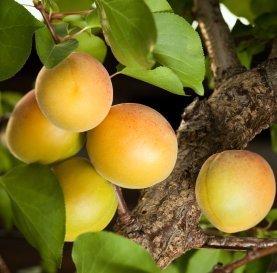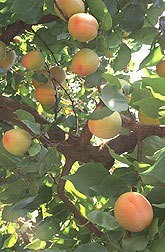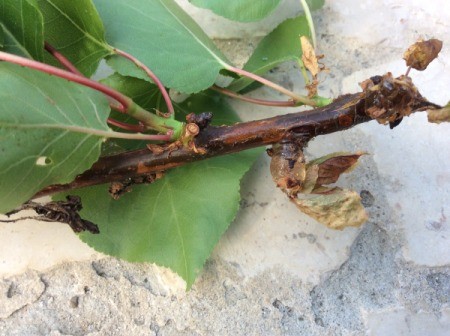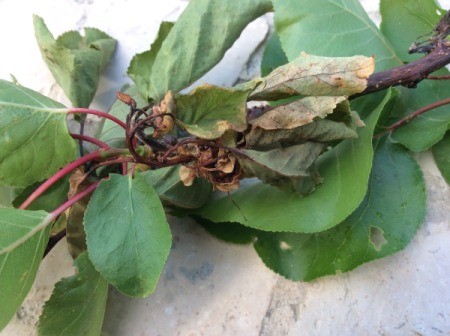
This page contains the following solutions.

Here are the questions asked by community members. Read on to see the answers provided by the ThriftyFun community.
I have an apricot tree that is 3 year old tree. The bottom of the fruit splits than rots, on at least 50% of the fruit.
Hardiness Zone: 9a
I don't know about apricots but other fruits split when the water situation is not right...too much I think.
I have had this happen to my tangelo, cherry tomatoes and seedless grapes.
From what I understand it is from inconsistent watering, the plants are getting too dry before you water again, when you do water the plant pumps the water into the fruit the skin does not strech fast enough there for its splits open, once that happens the bacteria gets to the fruit and the rot starts.
What do you do with your apricots once they are picked? I have a bag of them and don't know what to do with them!
My apples did this, I was told the tree wasn't getting enough water.
Am I watering my peach tree too much? Not all of the fruit splits. Peaches are the size of softballs. Very sweet and juicy.
This is the first time that I have had a peach tree or any other fruit tree. Please help, I don't want to loose my tree.
My tree trunk has split and the splitters are going up the tree. Now the fruit has brown strips, but when cut off the fruit is good. How do I stop the splitting and sap.
I read your note on growing cherries from the pit. I am trying to start other fruit.
Do the seeds of apricots and peaches requiring the same method, I have done everything except refrigerate the seeds and so far nothing. Thanks
. I've been told. Starting fruit from seeds it's possible but not practical.
Fruit will not come through from seed.
I have started avocados and peaches from seed, in CA what I have done is Mark out an area (so I don't plant something else there) where I want the tree to grow and I just put a whole bunch of seeds their, if I get more than 1 I pot up the rest.
You may end up with something absolutely delicious from seed you never know.
When you eat a peach apricot plum apple etc....just bury the pit in a small part of your garden
and most likely some will sprout in the Spring.
When the seedlings are about 2' or so tall,you can plant elsewhere during late winter.
There is a good chance that the trees will produce the original fruit albeit somewhat smaller,
or they may look entirely different.....
Their is also a chance that they may produce no fruit at all,...however it will take 3 years before you will see what they will bear.....one thing is for sure,you will no doubt enjoy a lot of fruit for your labour.
Remember: Since apricots are self fertile you probably stand a 50-50 chance of the pip reproducing a fruit very similar in size color and flavor to the one it came from. It probably will not be exactly like the parent plant as seedlings normally vary to begin with (that's how cultivars get selected-by having varied traits which the grower perceives as superior to the original parent plant). There is a possibility however of getting a cultivar which varies from the original fruits characteristics since the fruit probably came from an orchard grown tree where there may have been more then 1 cultivar of apricot being grown.
I myself plant to try growing an apricot from a pip as I cannot find the cultivar I want for sale as a grafted tree. I know I probably wont get the cultivar this way but am hoping to at least get fruit similar to what I ate in taste and color.
The cultivar I wanted is often grown commercially so it is possible I will get what I want from the pip anyhow, but I read it can take between 7 & 15 years for trees to mature and produce fruit if grown from seed. Is that true? I hope not because it will be really hard to wait 7 let alone 15 years for fruit.
I have an apricot tree that has a gooey looking substance ozzing out of the stems. Usually it kills the leaves and the tree struggles to produce fruit.
Is it fungus or a type of insect that effects it?


You may have more than one disease/insect.
i would recommend you discuss this with your local agriculture agency as they will be familiar with all of this.
Here are a couple of sites that have excellent disease control information:
www.starkbros.com/
homeguides.sfgate.com/
It is called bacterial canker. There is no treatment for existing cases. Nitrogen fertilizer and frequent light watering will prevent it in other trees
How do I get rid of bugs on an apricot tree?
By Mollie.H from Israel
A few months back I bought an apricot tree (about 5ft tall), from Home Depot. I am in 10a zone (so.CA). Now at the beginning of August, my apricot lost all foliage (no leaves). What could possibly have caused it? I thought, apricots are evergreen.
By Ed
Check out these photos.